LA Respiratory Issues
Nostrils and nasal conchae
Horses are obligate nasal breathers. They don’t have the option to breathe through their mouths unless other abnormalities are present. Nasal abnormalities can cause significant airway compromise. Alpacas and llamas are semi-obligate nasal breathers and can breathe for a bit through their mouths. However, they can’t breathe and eat or drink at the same time. Camels are bit more unique. Cattle can breathe through their mouths but do not unless very hot, very distressed or have significant pathology in the nasal region.
Common nasal and nasal conchae abnormalities with surgical therapies:
Choanal atresia
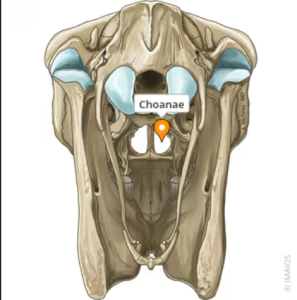
Choanal atresia occurs when the nasal passage fails to develop properly. Embryonically, the nasal passage opens from both directions. With atresia, the passages fail to meet in the middle, leaving an obstruction. One or both nostrils have a membrane that covers the oropharynx and prevents airflow. The membrane are located at the choanae- openings at the back of the nasal cavity leading to the pharynx. This means airflow does not reach the trachea from the nostril(s). If unilateral, symptoms are mild until the animals is older and/or exercising. If bilateral, it means a quick death for foals and respiratory distress for camelids.
Clinical signs (bilateral)
– Sudden death (animal cannot breathe except in rare cases)
Clinical signs (unilateral):
– Foal may appear normal until put into work
– Respiratory noise
– Exercise intolerance
– Asymmetric airflow through nostrils
Diagnostic tests:
– Endoscopy
– Skull radiographs +/- contrast
– Computed tomography
Treatment:
– First determine if animal has good quality of life with unilateral nostril affected- no treatment may be needed (non-athletes, camelids)
– Wait until for is >1 year old for treatment to allow nasal cavity to increase in size
Surgical options:
– Laser surgery with endoscopic guidance to incise membrane
– Nasal bone flap to access and resect membrane
– Resect laryngotomy through a laryngotomy
– Permanent tracheostomy
Prognosis:
– Rare condition in foals so there is not much data on prognosis
– Dependent on athletic needs of the animal
Future Considerations:
– A candidate gene has been identified in camelids. A genetic component has been suspected in horses. Affected animals should not be bred and the breeding that led to the cria should not be repeated. The contrast radiograph to the left (contrast inserted into the nostril) outlines the blind end of the nasal passage.
Nasal epidermal inclusion cyst
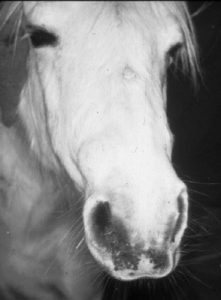
Nasal epidermal inclusion cysts occur in the false nostril (nasal diverticulum) of horses. These were previously identified as atheromas. While surgery was recommended in the past, the best treatment at this time is to inject the cyst with formalin. Formalin dries up the secretions and the dried out sack can removed digitally but usually falls out of the nostril on its own.
Conchal cyst
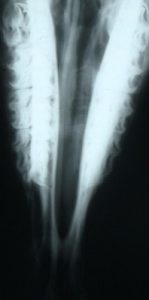 Conchal cysts are congenital anomalies that develop in the nasal conchae (scrollwork). These cysts can be very slow to develop and may not be identified until animals are adults. Clinical signs are associated with blockage of the nasal passage (lack of airflow, drainage issues) and deformation of the skull. Treatment involves surgical removal of the cyst, generally with a nasal flap procedure performed standing. A circular opacity can be seen in the center of the radiograph to the left.
Conchal cysts are congenital anomalies that develop in the nasal conchae (scrollwork). These cysts can be very slow to develop and may not be identified until animals are adults. Clinical signs are associated with blockage of the nasal passage (lack of airflow, drainage issues) and deformation of the skull. Treatment involves surgical removal of the cyst, generally with a nasal flap procedure performed standing. A circular opacity can be seen in the center of the radiograph to the left.
Wry Nose
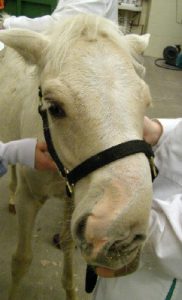
Wry nose is observed in newborn foals, calves and crias and is a severe malformation of the head. It is assumed to be a congenital disorder. Arabian horses are predisposed to this condition. The nasal septum is deviated with malalignment of the jaws and teeth. Generally the maxilla is most affected. While surgery is possible to improve the condition, affected animals continue to have restricted airflow and problems with dentition. Nasal septum changes can also occur with trauma to the nose. Surgical treatment can be attempted that requires extensive reconstruction of the nasal septum. Most affected animals are euthanized due to ongoing issues with breathing, chewing and dental related issues.

Dorsoventral radiograph of a one month old foal with wry nose.
Source: Equine Surgery. Auer and Stick 5th ed.
Nasal tumors
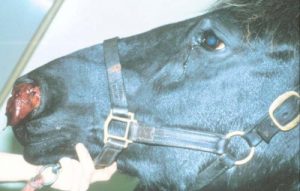 The most common nasal tumor is horses is a polyp, generally believed to develop from chronic irritation. Other tumor types can develop from the various tissues in the nose, including adenocarcinomas, adenomas, chrondromas, lymphosarcomas, osteosarcomas, and others. Enzootic nasal adenocarcinomas is a transmissible tumor of sheep and goats caused by a retrovirus. This tumor can occur in very young animals. Clinical signs include poor airflow/exercise intolerance, nasal discharge, nasal bone deformity and odor. Differentials for nasal tumors include granulomas and amyloidosis.
The most common nasal tumor is horses is a polyp, generally believed to develop from chronic irritation. Other tumor types can develop from the various tissues in the nose, including adenocarcinomas, adenomas, chrondromas, lymphosarcomas, osteosarcomas, and others. Enzootic nasal adenocarcinomas is a transmissible tumor of sheep and goats caused by a retrovirus. This tumor can occur in very young animals. Clinical signs include poor airflow/exercise intolerance, nasal discharge, nasal bone deformity and odor. Differentials for nasal tumors include granulomas and amyloidosis.
Resources
Disorders of the paranasal sinuses, Tremaine and Freeman
Diseases of the nasal passages in horses, Merck Manual
Respiratory distress in the adult and foal, VCNA (2021) 37:311-325

